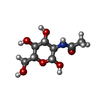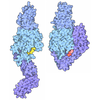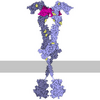+ Open data
Open data
- Basic information
Basic information
| Entry | Database: PDB / ID: 9p95 | ||||||||||||
|---|---|---|---|---|---|---|---|---|---|---|---|---|---|
| Title | CryoEM structure of integrin alpha4beta7 bound to MAdCAM-1 | ||||||||||||
 Components Components |
| ||||||||||||
 Keywords Keywords | CELL ADHESION / a4b7 / gut adhesion / lymphocyte homing / membrane receptor | ||||||||||||
| Function / homology |  Function and homology information Function and homology informationpositive regulation of lymphocyte migration / clathrin-dependent extracellular exosome endocytosis / : / diapedesis / immune response in gut-associated lymphoid tissue / cell-matrix adhesion involved in ameboidal cell migration / integrin alpha4-beta7 complex / integrin binding involved in cell-matrix adhesion / integrin alpha4-beta1 complex / cell-cell adhesion mediated by integrin ...positive regulation of lymphocyte migration / clathrin-dependent extracellular exosome endocytosis / : / diapedesis / immune response in gut-associated lymphoid tissue / cell-matrix adhesion involved in ameboidal cell migration / integrin alpha4-beta7 complex / integrin binding involved in cell-matrix adhesion / integrin alpha4-beta1 complex / cell-cell adhesion mediated by integrin / positive regulation of leukocyte tethering or rolling / axonogenesis involved in innervation / leukocyte tethering or rolling / RUNX3 Regulates Immune Response and Cell Migration / protein antigen binding / positive regulation of leukocyte migration / positive regulation of vascular endothelial cell proliferation / neuron projection extension / integrin complex / heterotypic cell-cell adhesion / negative regulation of vasoconstriction / leukocyte migration / leukocyte cell-cell adhesion / cell adhesion mediated by integrin / receptor clustering / cellular response to cytokine stimulus / endodermal cell differentiation / fibronectin binding / positive regulation of endothelial cell apoptotic process / Integrin cell surface interactions / positive regulation of T cell migration / coreceptor activity / T cell migration / cell adhesion molecule binding / substrate adhesion-dependent cell spreading / B cell differentiation / cell-matrix adhesion / integrin-mediated signaling pathway / Cell surface interactions at the vascular wall / cell-cell adhesion / integrin binding / cellular response to amyloid-beta / Immunoregulatory interactions between a Lymphoid and a non-Lymphoid cell / growth cone / virus receptor activity / Potential therapeutics for SARS / receptor complex / cell adhesion / immune response / external side of plasma membrane / focal adhesion / neuronal cell body / cell surface / signal transduction / extracellular exosome / metal ion binding / membrane / plasma membrane Similarity search - Function | ||||||||||||
| Biological species |  Homo sapiens (human) Homo sapiens (human) | ||||||||||||
| Method | ELECTRON MICROSCOPY / single particle reconstruction / cryo EM / Resolution: 3.05 Å | ||||||||||||
 Authors Authors | Hollis, J.A. / Campbell, M.G. | ||||||||||||
| Funding support |  United States, 3items United States, 3items
| ||||||||||||
 Citation Citation |  Journal: Sci Adv / Year: 2025 Journal: Sci Adv / Year: 2025Title: Molecular exaptation by the integrin αI domain. Authors: Jeremy A Hollis / Matthew C Chan / Harmit S Malik / Melody G Campbell /  Abstract: Integrins bind ligands between their alpha (α) and beta (β) subunits and transmit signals through conformational changes. Early in chordate evolution, some α subunits acquired an "inserted" (I) ...Integrins bind ligands between their alpha (α) and beta (β) subunits and transmit signals through conformational changes. Early in chordate evolution, some α subunits acquired an "inserted" (I) domain that expanded integrin's ligand-binding repertoire but obstructed the ancestral ligand pocket, seemingly blocking conventional integrin activation. Here, we compare cryo-electron microscopy structures of apo and ligand-bound states of the I domain-containing αEβ integrin and the I domain-lacking αβ integrin to illuminate how the I domain intrinsically mimics an extrinsic ligand to preserve integrin function. We trace the I domain's evolutionary origin to an ancestral collagen-collagen interaction domain, identifying an ancient molecular exaptation that facilitated integrin activation immediately upon I domain insertion. Our analyses reveal the evolutionary and biochemical basis of expanded cellular communication in vertebrates. | ||||||||||||
| History |
|
- Structure visualization
Structure visualization
| Structure viewer | Molecule:  Molmil Molmil Jmol/JSmol Jmol/JSmol |
|---|
- Downloads & links
Downloads & links
- Download
Download
| PDBx/mmCIF format |  9p95.cif.gz 9p95.cif.gz | 465.2 KB | Display |  PDBx/mmCIF format PDBx/mmCIF format |
|---|---|---|---|---|
| PDB format |  pdb9p95.ent.gz pdb9p95.ent.gz | 368.1 KB | Display |  PDB format PDB format |
| PDBx/mmJSON format |  9p95.json.gz 9p95.json.gz | Tree view |  PDBx/mmJSON format PDBx/mmJSON format | |
| Others |  Other downloads Other downloads |
-Validation report
| Summary document |  9p95_validation.pdf.gz 9p95_validation.pdf.gz | 1.4 MB | Display |  wwPDB validaton report wwPDB validaton report |
|---|---|---|---|---|
| Full document |  9p95_full_validation.pdf.gz 9p95_full_validation.pdf.gz | 1.4 MB | Display | |
| Data in XML |  9p95_validation.xml.gz 9p95_validation.xml.gz | 50.9 KB | Display | |
| Data in CIF |  9p95_validation.cif.gz 9p95_validation.cif.gz | 76.8 KB | Display | |
| Arichive directory |  https://data.pdbj.org/pub/pdb/validation_reports/p9/9p95 https://data.pdbj.org/pub/pdb/validation_reports/p9/9p95 ftp://data.pdbj.org/pub/pdb/validation_reports/p9/9p95 ftp://data.pdbj.org/pub/pdb/validation_reports/p9/9p95 | HTTPS FTP |
-Related structure data
| Related structure data |  71399MC  9p96C  9p97C  9p98C  9p99C M: map data used to model this data C: citing same article ( |
|---|---|
| Similar structure data | Similarity search - Function & homology  F&H Search F&H Search |
| Experimental dataset #1 | Data reference:  10.6019/EMPIAR-11765 / Data set type: EMPIAR 10.6019/EMPIAR-11765 / Data set type: EMPIAR |
- Links
Links
- Assembly
Assembly
| Deposited unit | 
|
|---|---|
| 1 |
|
- Components
Components
-Protein , 3 types, 3 molecules ABC
| #1: Protein | Mass: 113632.453 Da / Num. of mol.: 1 Source method: isolated from a genetically manipulated source Details: Ectodomain / Source: (gene. exp.)  Homo sapiens (human) / Gene: ITGA4, CD49D / Production host: Homo sapiens (human) / Gene: ITGA4, CD49D / Production host:  |
|---|---|
| #2: Protein | Mass: 84538.789 Da / Num. of mol.: 1 Source method: isolated from a genetically manipulated source Source: (gene. exp.)  Homo sapiens (human) / Gene: ITGB7 / Production host: Homo sapiens (human) / Gene: ITGB7 / Production host:  |
| #3: Protein | Mass: 39205.062 Da / Num. of mol.: 1 Source method: isolated from a genetically manipulated source Details: Ectodomain without mucin domain / Source: (gene. exp.)  Homo sapiens (human) / Gene: MADCAM1 / Production host: Homo sapiens (human) / Gene: MADCAM1 / Production host:  |
-Sugars , 3 types, 7 molecules 
| #4: Polysaccharide | alpha-D-mannopyranose-(1-3)-beta-D-mannopyranose-(1-4)-2-acetamido-2-deoxy-beta-D-glucopyranose-(1- ...alpha-D-mannopyranose-(1-3)-beta-D-mannopyranose-(1-4)-2-acetamido-2-deoxy-beta-D-glucopyranose-(1-4)-2-acetamido-2-deoxy-beta-D-glucopyranose Source method: isolated from a genetically manipulated source | ||
|---|---|---|---|
| #5: Polysaccharide | Source method: isolated from a genetically manipulated source #6: Sugar | |
-Non-polymers , 2 types, 6 molecules 


| #7: Chemical | | #8: Chemical | |
|---|
-Details
| Has ligand of interest | N |
|---|---|
| Has protein modification | Y |
-Experimental details
-Experiment
| Experiment | Method: ELECTRON MICROSCOPY |
|---|---|
| EM experiment | Aggregation state: PARTICLE / 3D reconstruction method: single particle reconstruction |
- Sample preparation
Sample preparation
| Component | Name: Protein complex of integrin alpha4beta7 bound to MAdCAM-1 Type: COMPLEX / Entity ID: #1-#3 / Source: RECOMBINANT |
|---|---|
| Source (natural) | Organism:  Homo sapiens (human) Homo sapiens (human) |
| Source (recombinant) | Organism:  |
| Buffer solution | pH: 7.4 / Details: 0.05% CHAPS added immediately before vitrification |
| Specimen | Conc.: 1 mg/ml / Embedding applied: NO / Shadowing applied: NO / Staining applied: NO / Vitrification applied: YES |
| Vitrification | Cryogen name: ETHANE |
- Electron microscopy imaging
Electron microscopy imaging
| Microscopy | Model: TFS GLACIOS |
|---|---|
| Electron gun | Electron source:  FIELD EMISSION GUN / Accelerating voltage: 200 kV / Illumination mode: FLOOD BEAM FIELD EMISSION GUN / Accelerating voltage: 200 kV / Illumination mode: FLOOD BEAM |
| Electron lens | Mode: BRIGHT FIELD / Nominal defocus max: 1800 nm / Nominal defocus min: 1200 nm |
| Image recording | Electron dose: 50 e/Å2 / Film or detector model: GATAN K3 (6k x 4k) |
- Processing
Processing
| EM software |
| ||||||||||||||||||||||||
|---|---|---|---|---|---|---|---|---|---|---|---|---|---|---|---|---|---|---|---|---|---|---|---|---|---|
| CTF correction | Type: PHASE FLIPPING AND AMPLITUDE CORRECTION | ||||||||||||||||||||||||
| 3D reconstruction | Resolution: 3.05 Å / Resolution method: FSC 0.143 CUT-OFF / Num. of particles: 188443 / Symmetry type: POINT | ||||||||||||||||||||||||
| Refinement | Highest resolution: 3.05 Å Stereochemistry target values: REAL-SPACE (WEIGHTED MAP SUM AT ATOM CENTERS) | ||||||||||||||||||||||||
| Refine LS restraints |
|
 Movie
Movie Controller
Controller







 PDBj
PDBj








